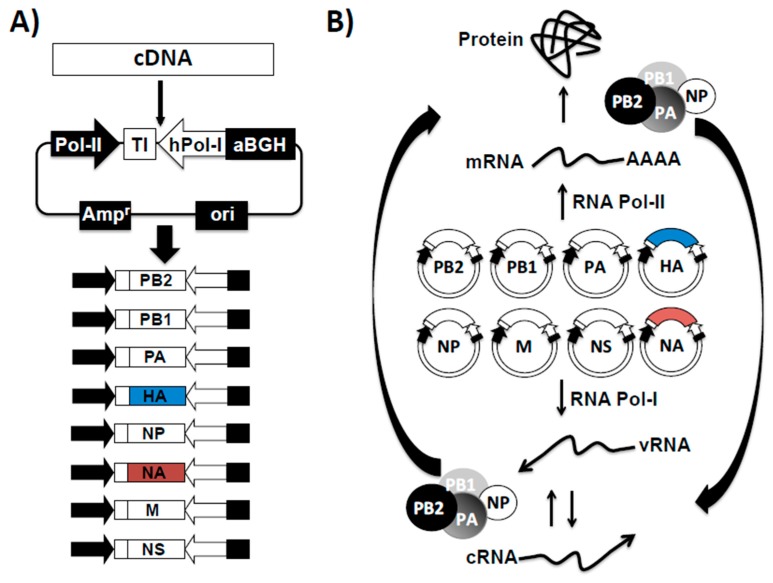Figure 3.
Influenza vRNA cloning into bi-directional rescue plasmids. (A) Schematic representation of an ambisense plasmid, influenza cDNA inserts and generation of influenza rescue plasmids: The ambisense plasmid is a bi-directional vector containing the human polymerase I promoter (hPol-I, white arrow) and the mouse Pol-I terminator (TI, white box) sequences to direct the synthesis of the influenza vRNAs. Transcription from the Pol-I cassette results in vRNAs identical to those present in influenza virus, allowing their recognition by the influenza polymerase complex. In opposite orientation to the Pol-I cassette, a polymerase II-dependent cytomegalovirus promoter (Pol-II, black arrow) and a polyadenylation sequence (aBGH, black box) direct the synthesis of influenza proteins from the same viral cDNAs; (B) Influenza plasmid-based reverse genetics: In cells transfected with the influenza ambisense plasmids, the Pol-I cassette generates the eight negative sense vRNAs (bottom) while the Pol-II directs the synthesis of the eight viral mRNAs (top) that are translated into the influenza viral proteins. After translation, influenza NP and polymerase complex PA, PB1 and PB2 associate with the vRNAs to form the viral ribonucleoprotein (vRNP) complexes and initiate transcription from the viral promoter located within the non-coding regions at the 3′ termini of the vRNAs. Transcription results in the synthesis of more mRNAs and proteins. The influenza polymerase complex also replicates the vRNAs into complementary (c)RNAs that serve as templates for the amplification of vRNAs. Newly-synthesized vRNAs, together with the structural viral proteins result in the formation of new influenza viruses. Blue and red boxes indicates the HA and NA of seasonal influenza viruses to be included in either the IIV or the LAIV vaccine, respectively. Ampr: ampicillin resistance gene; Ori: plasmid origin of replication.

